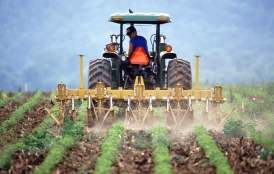The Stanford School of Earth, Energy & Environmental Sciences is now part of the Stanford Doerr School of Sustainability.
This page is currently being maintained for archival purposes only. For the latest information, please visit us here.
Crop yields likely to fall with rising temperatures
An increase of more than two degrees Celsius in average global temperature is likely to cause yields of wheat, rice and maize to fall throughout the 21st century. Early adaptation could increase projected yields by up to 15 percent.
By
Laura Seaman
March 17, 2014
Flickr

If global temperatures continue to rise, the amount of crops farmers can harvest will sharply decline during the next 100 years.
Stanford professor David Lobell and an international team of climate scientists modeled future crop yields under several global climate scenarios throughout the 21st century. They found that if average global temperatures rise by more than two degrees Celsius, farmers are likely to get less wheat, rice and maize out of each plot of land. Yields will fall by an average of 4.9 percent for every one degree Celsius rise in average temperature. Year-to-year variability of harvests is also expected to rise, as drought and flooding become more frequent. Crop yield losses will speed up throughout the century, with declines in yield beginning around 2030 and with the fastest drop happening in the second half of the century.
Lobell, an associate professor of Environmental Earth System Science and associate director of the Stanford Center on Food Security and the Environment, reviewed more than 1,700 published studies with a team of climate scientists from the United States, United Kingdom and Australia. The team found that if farmers adapt to climate change within the next few years, they have a better chance of avoiding or even reversing the predicted decline of wheat and rice yields in some regions. Agricultural adaptation strategies like irrigating fields and developing new crop breeds could increase projected yields between 7 percent and 15 percent.
The new study also highlights the need for better data on the potential future impacts of other factors that affect crop yields, like the prevalence of pests and plant diseases, and the availability of water supply. A full version of the study can be found online at Nature Climate Change.
Laura Seaman is Communications and External Relations Manager in the Stanford Center on Food Security and the Environment







